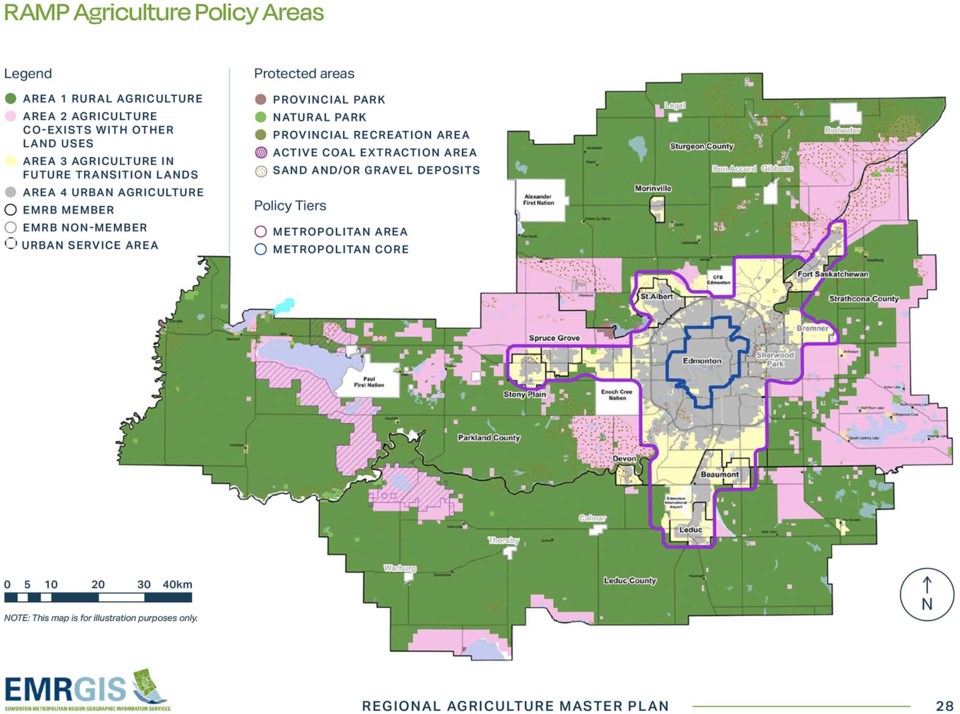Sturgeon County’s mayor has voted against a regional agricultural plan she helped make in protest of a regional voting structure she argues treats county residents as serfs.
Edmonton Metropolitan Region Board members voted 12-1 in favour of adopting the Regional Agricultural Master Plan on Aug. 12.
The plan, once approved by the provincial government, will require all Edmonton-area governments to restrict development on prime agricultural lands to preserve farmland and protect local food production.
Sturgeon County Mayor Alanna Hnatiw was on the board’s agricultural plan task force and voted against the plan.
“Producers cannot in any way return to any form of serfdom in a feudal system on land they are dependent on,” Hnatiw said.
“(The land) is their home and it is their business.”
In an interview, Hnatiw explained that her vote was a protest against the board’s voting rules rather than plan itself, the principle of which she supported.
The region board requires any motion to have the support of two thirds of its members (eight out of 13) representing two thirds of the region’s population. This gives Edmonton an effective veto on any motion due to its population. Hnatiw said these rules also allowed the board to theoretically pass policies that had an outsized impact on rural counties (such as the agricultural plan) without the support of any of the board’s four rural counties.
Hnatiw said she was concerned the board’s voting rules would make it tough for rural communities to make changes to the plan should problems occur. She called for the rules to be changed to require the support of at least one county in any successful vote.
Rural board members have made multiple attempts to change the metropolitan region board’s voting rules over the years, none of which have succeeded.
What the agricultural plan means
The Regional Agricultural Master Plan itself is part of the region board’s growth plan, which outlines how the region is to develop in the next 30 years. All municipal plans and laws are required to follow it.
The Edmonton region is the most productive agricultural zone in Alberta, being home to 35 per cent of the province’s best soils and a quarter of its food and beverage processing sector, the agricultural plan report found. With the proper support, the region’s agricultural sector could double in size to $27 billion in annual total economic output by 2046.
“We have the opportunity to become a global agricultural powerhouse by focusing on creating the right conditions for this sector to thrive,” said Edmonton Coun. Michael Walters, co-chair of the agricultural plan task force.
Economic analysis suggests the Edmonton region is on track to lose some 600,000 acres of farmland in the next 30 years, board members heard — an area about 1.2 times the size of Sturgeon County. The agricultural plan’s policies could reduce this to 100,000 acres.
The agricultural plan divides the Edmonton region into four zones — rural agriculture, agriculture with other uses, agriculture in transition, and urban agriculture — each with different levels of protection for farmland.
Almost all of Sturgeon County falls under rural agriculture. Agriculture is to be the priority land use in this zone, and governments are to pass laws to ensure farmers can farm and expand their operations without undue interference from other land uses. Non-farm uses are to be discouraged and subject to agricultural impact assessments before they can proceed. Gravel, coal, and other resource extraction can occur, but only if affected soils are restored to their original or better state afterward.
Sturgeon County farmers in this area will not be allowed to sell their farms to build a new subdivision, Hnatiw explained — something that is already banned under the current growth plan, she noted. The agricultural plan could let them develop less fertile areas of their property, though, allowing them to get more use out of their land.
“Most people who have Class One (really fertile) soil here are making a decent living off it,” she added, and would be happy to keep farming with the necessary financial and federal supports.
The rest of the county is listed under the "agriculture with other uses" (e.g. farms in Alberta’s Industrial Heartland) or "agriculture in transition" (the borderlands with St. Albert) zones. Under the agricultural plan, farmland in these areas is to be protected until it is needed for some other use.
Hnatiw said there are still many unanswered questions about these two zones. Can you pave over a farm here as soon as a developer buys it, for example? Can St. Albert start building here now, or does it have to fill all its vacant lots first?
Morinville and St. Albert fall under urban agriculture. The agricultural plan requires governments to create urban agriculture plans for these areas within two years that identify opportunities and constraints for urban agriculture.
Morinville Mayor Barry Turner said such a plan for Morinville would likely involve public education about agriculture and build off of the town’s community garden and Incredible Edibles programs. The agricultural plan itself could draw more value-added agricultural firms to Morinville, and would also force the town to be cautious in how it grows.
“It’s not a bar on future expansion of our urban centres,” he said, but it definitely encourages denser development.
Hnatiw hopes the Regional Agricultural Master Plan will give farmers some peace of mind by reducing the odds that a new subdivision will pop up next to them. She encouraged all county residents, especially those doing estate planning, to check the plan out.
The Regional Agricultural Master Plan document can be found www.emrb.ca/agriculture.




